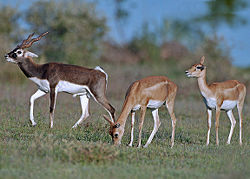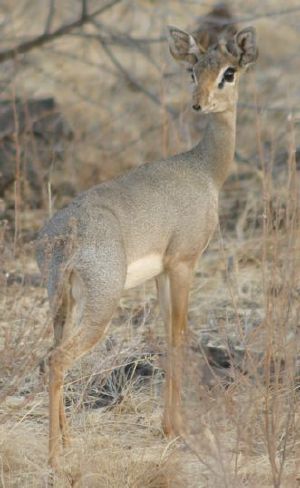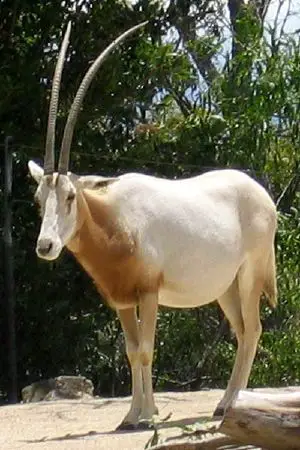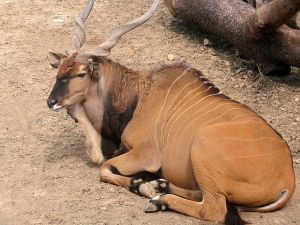Antelope
| Antelope | ||||||||||
|---|---|---|---|---|---|---|---|---|---|---|
 Blackbuck | ||||||||||
| Scientific classification | ||||||||||
|
Antelopes are various members of the family Bovidae or bovids, of the even-toed ungulates or hoofed mammals. Antelope species do not form a taxonomic group are spread throughout the various subfamilies of Bovidae; many are more closely related to cattle or goats than to each other. There are many different species of antelope, ranging in size from the tiny royal antelope, which weighs about 3.5 kg (8 lbs), to the giant eland, up to 900 kg (2000 lbs). They typically have a light, elegant figure, are slender, have graceful limbs, small cloven hoofs, and a short tail.
The pronghorn of North America is often called an antelope. Although it is very antelope-like it is not a true antelope since it is not a member of the Bovidae family.
Range and Habitat
The greatest number of antelope species are found in Africa, where they live throughout the continent. A few are found in southwest Asia, in India, and in central Asia. Most species live in grasslands or in savannas, mixed forest and grassland. Some, mostly the smaller species, live in dense tropical forests and some live in deserts and mountainous areas (Bere 1970).
Physical Description
All antelopes have long, slender legs and powerful muscles where the upper legs meet the body, providing leverage and increasing leg stride and speed. Antelopes are fast runners, although they are not the fastest animals in the world. They are good at quick, precise turns, and they can run very fast for extended periods of time. This gives them an advantage over many predators such as the cheetah, which relies on sprinting and can be tired out by the antelope's greater stamina.
Antelopes bear a dense coat with short fur. Most antelopes have fawn or brown-colored fur which makes them harder to see. There are some exceptions, including the rare zebra duiker which has dark vertical stripes, and the gemsbok which has gray and black fur and a vivid black-and-white face. A common feature of the gazelle is a white rump, which flashes a warning to others when it runs from danger. One species of gazelle, the springbok, also has a pouch of white brushlike hairs running along its back. When a springbok senses danger, its pouch opens up, and the hairs stand on end.
Antelopes are ruminants. Like other ruminants, such as cattle, goats, andsheep, they have well-developed cheek teeth or molars, which grind cud into a pulp. They have no upper incisors or canines; in order to tear grass stems and leaves, their lower incisors press against a hard upper gum pad when they bite.
Antelopes rely on their keen senses to avoid predators. The word "antelope" comes from a Greek word meaning "brightness of eye." Their eyes are on the sides of their heads, and their pupils are elongated horizontally, giving them a broad view of danger from both the back and front. Their senses of smell and hearing are also acute, giving them the ability to perceive danger while out in the open where predators often prowl after dark.
Both sexes of most antelope species grow horns, with the males' horns generally larger. The dik-dik and klipspringer, two species where the male mates with only one female, have horns that are little more than spikes. However, in species where males compete to mate with several females, horns may grow as long as 1.5 m (5 ft). Despite their large size, antelope horns are hollow and lightweight. Antelope horns are almost always slightly curved, although in some species such as the blackbuck, they are spiraled.
In many species, the males are larger than the females. In several species, such as the Asian blackbuck, males and females also differ in color.
Behaviour
Almost all antelopes are social animals, living in groups called herds. They communicate with each other using a varied array of sounds. For example, dik-diks whistle when alarmed, warning animals of other species of the danger as well.
Generally, though, sight is a much more common form of communication than sound among antelopes. An antelope's mood is indicated by its posture and movement. When excited or alarmed, most medium-sized species of antelope bounce up and down on all four legs, keeping them stretched out straight. This behavior, known as pronking or stotting, acts as an alarming display. Some biologists theorize that stotting also sends a message to predators, showing that individual antelopes are fit and alert, and therefore not worth pursuing.
Antelopes also use scent signals to communicate; these signals can linger for many days. Antelopes that live in herds have glands in their hoofs which leave a scented record of their movement. If an antelope were to be accidentally separated from its herd, it would be able to follow the scent tracks back.
Antelope species common to forests tend to stay in the same place all their lives, but species that live out in the open often migrate. The wildebeests, also called gnus, carry out the most famous of these migrations through the plains of eastern and southern Africa. Wildebeests are sedentary in some places, but in others, such as Serengeti National Park, they travel between two different home ranges. One of these ranges is used during the dry season, while another is used during the wet season. Migration can be very risky; the dangers include crossing crocodile-infested rivers, but migration supplies them with food at different times of the year.
Antelopes and predators
Antelopes and humans
ReferencesISBN links support NWE through referral fees
- Bere, Rene.1970. Antelopes. New York : Arco Publishing Company, Inc. ISBN 688018461
- Huffman, B. 2007. The Ultimate Ungulate Page Website [1] Retrieved February 7, 2007.
- IUCN Species Survival Commission (IUCN). 2007. .2006 ICUN Red List of Threatened Species. International Union for Conservation of Nature and Natural Resources. Retrieved February 7, 2007.
- Nowak, R. M. and J. L. Paradiso. 1983. Walker's Mammals of the World. Baltimore, Maryland: The Johns Hopkins University Press. ISBN 0801825253
- Voelker, W. 1986. The Natural History of Living Mammals. Medford, New Jersey: Plexus Publishing, Inc. ISBN 0937548081
Credits
New World Encyclopedia writers and editors rewrote and completed the Wikipedia article in accordance with New World Encyclopedia standards. This article abides by terms of the Creative Commons CC-by-sa 3.0 License (CC-by-sa), which may be used and disseminated with proper attribution. Credit is due under the terms of this license that can reference both the New World Encyclopedia contributors and the selfless volunteer contributors of the Wikimedia Foundation. To cite this article click here for a list of acceptable citing formats.The history of earlier contributions by wikipedians is accessible to researchers here:
The history of this article since it was imported to New World Encyclopedia:
Note: Some restrictions may apply to use of individual images which are separately licensed.




